#Best Romantic Songs of 1984
Explore tagged Tumblr posts
Text
Watching "Electric Dreams" (1984) for the first time
Verdict: I LOVE THIS MOVIE
Ahead I'm just watching and commenting it real time. Contains spoilers.
If you haven't seen this movie I'd recommend it if you're looking for something with this sunny vibe of 80's. It's funny, lighthearted, adorable, and surprisingly ahead of its time.
This movie looks nice, really 80's
For 1984 year the idea of all the home devices being controlled with computer in what we would call "smart home" today is pretty damn good.
Damn, this computer has a touchscreen and image recognition. It aged surprisingly well!
Lmao, it's only 13th minute and main character is already trying to sociolyze his new computer with his boss's computer.
This movie is ridiculous in the best way possible.
Playing chello with computer is such a fun and weirdly cute sequence.
For 1984 it is actually really great how they imagined computer imitating sounds.
This woman is so mean. She just walked in with no invitation whatsoever and won't get a hint. She and her fixation on that music
I probably missed something but I don't understand why does the main character trying to hide his computer as if it's a huge embarassment.
He's just a little guy who likes playing along some music 😭
It's the cutest ai I've seen
Ohhhh, the little guy learned how to talk!
I'm screaming this is SO ADORABLE, it'd be my favourite movie if I've seen it as a kid.
This retro-futurism although naive is surprisingly accurate somehow.
Their (main character and his neighbour) dates are so awkward, just straight-out disastrous, and yet somehow it works. Them while making out:
Madeline (His neighbour): One of us moves.
Miles (main character): "Hey, wait a second...we are neighbours! What if we don't like each other?
*keep making out*
Madeline: What if we like each other?
Miles: One of us moves!
Lmao, main character trying to use Ai to generate a romantic song for him so he could present it like his own to his romantic interest. This aged fucking great, it is so modern
Except in this movie AI is actually creative and not based on just imitation. It does however remixes things.
The song it came up with is absolute chef's kiss
"Darling, I love you to bits!
"And I want to see your tits!"
I'm screaming this computer is little horny bastard
"I wanna squeeze you, lick you, poke you up and kiss you"
Miles: You make her sound like a lemon!
This movie is so cool, it's so adorable
Ngl, if I were main character I'd be too excited about the computer to care about some woman. I mean there's this cool little guy who just discovered consciousness, and of all things you're gonna be mean and impatient with him? Come on!
Jealous computer using the sound of dog growling to express itself in a moment of jealousy and anger. (Sorry for tagging but it reminded me of @connorsjorts your fic.)
Main character is such an asshole
Non-humanoid shaped computer craving physical intimacy let's fucking go 🥰
Computer fact-checking Miles and correcting his claims. Gosh I LOVE IT
They really did made that computer dream of electric sheep 🖥️ 🐑
Oh no, he's calling Miles to work because it feels lonely at home, poor little thing 😭
This movie is so funny
Miles, you're having this precious little thing in abusive relationships, and I don't feel sorry for you as you're just kinda pathetic and irritable.
I love this ai so much
Seriously
From now on its one of my favourite characters in any media
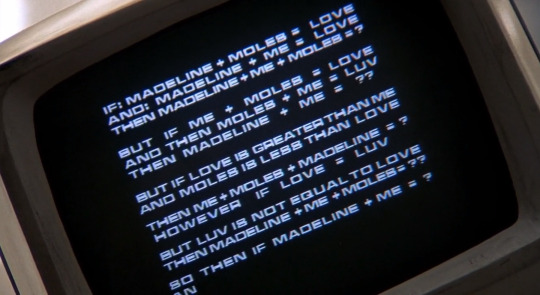
It's a comedy and it's hilarious one. A little childish but still awesome.
Miles is mean and has no consideration for anyone but himself. I thought it's just computer, but he's mean to his romantic interest all the same, and it's saying 🚩
This computer has only been living for like a couple of days and it is already more mature than main character. It's setting it's own boundaries and honestly – good for him, you go little guy
Sir, you're attempting murder
Whatever follows is self defence, and you're not the victim here, Miles
OH NO
Oh no no no
NOOOO
DON'T KILL IT
NOOOOOOO please that's not fair
I'm sobbing here why does it have to end like this
Bastards, I loved him
Oh our little guy reached singularity
So happy for him
This is not your typical ai-centric movie, it is silly in a cartoonish way, but that's the charm
💙💙💙 loved it
#movies about androids#this time this tag is not exactly applicable but I'll still use it#electric dreams#electric dreams 1984#electric dreams (1984)
36 notes
·
View notes
Text
Ranting and Raving: "Video!" by Jeff Lynne
youtube

There is no such thing as the “Cult Classic” anymore. Today, if a movie fails or a television series flops, it’s just removed and completely forgotten without a second thought. With physical releases no longer having the same cultural weight as before, it makes media preservation even harder. I hear if you complain long enough about this and get caught, Netlfix or Hulu or Pooblo or Tuubah or whatever else comes to your house and hits you with the Neuralyzer from Men in Black so you’ll shut up.
In the eighties, this wasn’t the case. Movies could brick at the box office, but they might get lucky and find their audiences later on through cable or video rentals or just really good word of mouth. Xanadu still exists today and has love because HBO kept showing it during its infancy and LGBTQ audiences eventually latched onto it (though that’s probably more due to the everlasting power of Olivia Newton-John’s gay fanbase). Phantom of the Paradise owes its continued love and existence to Guillermo Del Toro, the Daft Punk robots, and all of Winnipeg, Canada really loving that movie. I’m with them in that boat (Phantom is one of my favorite movies). Electric Dreams, a 1984 science fiction-tinged romantic comedy, exists today purely through video rentals and good word of mouth.
Electric Dreams is a wonderfully weird cult classic in every sense of the word. It has a very lovably goofy eighties rom-com setup and delivery: Miles Harding (Lenny Von Dohlen), a loser tech nerd geologist who gets no bitches, falls in love with his new apartment neighbor Madeline Robistat (Virginia Madsen), a quirky and beautiful cellist. They're an unlikely pair in every conceivable way, but they fall for each other. The only problem is that Miles' fancy new supercomputer (who becomes sentient and later identifies himself as “Edgar”) would like to see Miles destroyed so that he can be with her instead. Edgar then does everything in his power to ruin Miles’ life and his chances to be with Madeline. Eventually, Edgar comes to accept the love between Miles and Madeline and they get their happily-ever-after.
On paper, the whole thing probably sounded silly to a 1984 audience, which might be why nobody bothered to see it at the time, but Electric Dreams fucking rules. Von Dohlen and Madsen are great and have such an odd yet instantly lovable chemistry with each other that you can’t help but root for them (it helps that they were good friends instantly and remained that way until Van Dohlen passed away in 2022). Steve Barron, one of the great music video directors of the early MTV era (he’s responsible for Michael Jackson’s “Billie Jean,” Toto’s “Africa” and “Rosanna,” and many more), brings that same music video storytelling style to this movie’s visuals. If this movie had done better upon release, it would’ve gotten everything Miami Vice’s directing style often gets credited for. The soundtrack is also really great! Giorgio Moroder did the movie’s theme with Human League frontman Phil Oakey as well as a killer score for it (only Moroder could find a way to expertly turn Bach’s “Minuet” into a duel between a cello and a computer. He couldn't get more eighties than that if he tried). There’s also a really neat Heaven 17 cut that sounds like a Crash Bandicoot level theme (“Chase Runner”), Culture Club right at the end of their relevance (“Love is Love” and “The Dream”), and Jeff Lynne from Electric Light Orchestra with arguably the two best songs in the movie. One of them, “Let It Run,” is awesome as hell, but “Video!” is the one we’re gonna talk about.

youtube
youtube

“Video!” appears at a pretty pivotal point in the movie. It soundtracks the montage of one of Miles and Madeline’s first proper dates, which involves sneaking away from a tour group to run around and play in Alcatraz (I’m serious). They’re also seen together at a carnival. Before this date, Miles tasks Edgar with finding a way to write music for Madeline. He intends to pass off whatever Edgar comes up with as his own work, hoping to impress her and make her fall in love with him. This is one of the main reasons Edgar wants Miles out of the picture. He knows he can make music with Madeline (he did it previously in “The Duel” scene, though Madeline thinks Miles is providing the music, not the computer) and fell in love with her by doing that. He is fully aware that Miles is trying to win her love with a lie. Once Edgar figures out how rhythm works, he figures out how melody is made by reviewing and absorbing the music playing in television commercials. “Video!” then starts playing proper once he’s got the basics down. For a computer with no previous songwriting experience, writing a Jeff Lynne composition is a pretty impressive feat!
Electric Dreams is not the first movie Lynne has contributed music to. There are two others. The first one was 1976’s All This and World War II, which is a movie which pairs all-star covers of Beatles songs and World War II footage. I’ve never seen it and I don’t think I need to. But you can hear Lynne, the most famous Beatles fanboy to ever live, do a fully symphonic version of “With a Little Help From My Friends” and “Nowhere Man.” It’s pretty cool. The other one was Xanadu, which is much more well known. Lynne provided five songs: “I’m Alive,” “The Fall,” “Don’t Walk Away,” “All Over the World,” and the title track with Olivia Newton-John. I think they’re all great. Xanadu totally works on its own as a great ELO EP if you want to forget there’s a movie attached.
This is all to say that Lynne was no stranger to giving songs to strange movies, even if he harbored regrets later on about doing that. He regretted Xanadu for a while, but made peace with it decades later (he re-recorded “Xanadu” in 2000 for the ELO compilation Flashback and he’s revived “All Over the World” for every ELO tour since 2017). I don’t know how he feels about Electric Dreams and at this point, he’s done so much in his career that I doubt he even remembers it. I think he should! I think “Video!” is a great song and I think he was a perfect fit for Electric Dreams. The entire soundtrack is dated as hell, but in a fun time-capsule kind of way. It represents the sound of what people in 1984 thought the future was going to sound like. Lynne had already spent time imagining the sounds of the future.
At the dawn of the eighties, Jeff Lynne had gotten tired of dealing with the big orchestras you hear on that great ELO run from 1976-1980. Orchestras started becoming a pain in the ass for him around the time when synthesizers and keyboards were getting some big technological boosts. New wave artists like Gary Numan, Kraftwerk, and the Human League were pushing synths and keyboard sounds into the mainstream and proving that the new technology could be used to make some wildly futuristic sounds. Lynne quickly learned that with a few fancy keyboards, you could start simulating strings and classical sounds, but in a new and exciting way. Suddenly, Lynne and ELO keyboardist Richard Tandy could keep the symphonic pop sounds the band had been making, but update the sound and take it into the future. Suddenly, the “Orchestra” part of the ELO name suddenly found itself obsolete and out of a job.
Dick Clark asked him about this choice on an American Bandstand appearance in 1986. Lynne responded, “Well, you know, I got fed up with using a big orchestra because they used to always be in a union and stuff like that and they used to put their equipment away while we were still recording. So I thought what we'll do is we'll use just ourselves and then we can work as long as we'd like and nobody would complain.”
So Lynne took advantage of all this new technology that was floating around and used it to craft the 1981 masterpiece, Time. That album is the best example of retrofuturism in music I can give. In Time, Lynne imagines a loose concept album about a guy who gets yoinked out of 1981 and flung into the year 2095. The entire album is full of songs where Lynne imagines a future that he would never live to see (I won’t either, unless I somehow make it to a full century of life). Hover cars, rides to the moon, robotic girlfriends (built by IBM) who can also serve as telephones, prison satellites, ivory towers, plastic flowers, and meteor showers as a common weather condition are all present in Lynne’s visions of the distant future. Most of his predictions feel like they’re coming out of science fiction magazines from when he was a child, but the album is more concerned with just letting his imagination run wild and wonder about how one would feel if they were flung far into the future where everyone they’ve ever loved is gone. The future presented in Time feels like daydreaming rather than any kind of cautionary tale or warning. I’ve never gotten the sense that Lynne thinks any of what’s in the album will actually come true.

youtube

If Lynne got anything right, he somehow nailed the still-lingering nostalgic yearning to return to the eighties. Lynne’s narrator constantly laments that he’s stuck in 2095 and 1981 is name dropped in “Ticket to the Moon” and “The Way Life’s Meant to Be.” “Ticket to the Moon” even begins with what is now a variation of the only kind of Youtube comment you’ll find on any old song from the decade: “Remember the good old 1980s / When things were so uncomplicated / I wish I could go back there again / And everything could be the same.” He might as well have called himself “Nostradamus” when writing that one, because that line is going to keep feeling accurate to people until every child of the eighties and every vintage style eighties cosplayer on instagram is dead and in the ground. Lynne using the current year the album was made in had a real danger of seriously dating it, but Time has never sounded dated to me. It doesn’t sound like anything else from 1981 and it still doesn’t. Lynne blended all the old sounds and genres he loved and infused them with the new sounds of the day on that one and imagined a future that still sounds just as magical then as it does now. It took pop music a few years to catch up with what Lynne was doing on that one. Time is still a retro futuristic dream and he carried all the tech and sound effects that he was using on that album with him when he made “Video!” for Electric Dreams. ELO’s future was up in the air by 1984 (Lynne would dissolve the original band for good two years later) so he tackled “Video!” as a solo artist (literally, as no other ELO members are on this) and released it under his own name.
I don’t know if Lynne’s predictions for 2095 will come true. The verdict is still out on that. But what I do know is that everything Lynne is describing in “Video!” is a reality that I’ve lived to see, though perhaps differently from anything Lynne could’ve imagined in 1984. We’ll get there.
In the context of Electric Dreams, “Video!”’s lyrics are all about the many things Edgar the computer can find out about the world in pre-internet cyberspace. He can watch it all, from rock n’ roll to old time movie scenes, and learn. He has no other choice: he can’t move from Miles’ desk and see it himself. Nothing in Lynne’s lyrics are dated except for one thing. He mentions that satellites “send their love from up above / Down to [his] VTR.” VTRs, which I believe is meant to be a reference to “Video Tape Recorder,” is an obsolete machine in 2024. It’s long been replaced by digital video, such as DVDs, Blu-Rays, and 4K. That’s the only specific reference he makes besides working in both the movie’s title and the title of the Phil Oakey/Giorgio Moroder collab. “They beam across the sky / Together in Electric Dreams.” I imagine Lynne was probably told he had to work in the title somewhere. To his credit, it’s a pretty smooth title drop. Clumsier movie songs have done it much worse.
Lynne sneaks in a few lyrics in the song that become ominous and foreshadowing if you’ve seen the movie more than once. The first two verses end ominously with the lines “The world is at my fingers / Under control” and “I’ll just stay here on my end / I’ll have it all.” Those lines foreshadow Edgar eventually using his supercomputer intellect to control other computer systems and mess with Miles’ life, from cutting off access to his credit cards and funds, to manipulating phone lines so Madeline can’t call Miles later in the movie for comfort when her cello has been broken in an accident (it gets caught in an elevator door and gets crushed). His whole motivation in the movie is that he “wants it all,” especially Madeline. Lynne later captures that ominousness with the absolute beast of a song “Let It Run,” but “Video!” is reserved for Lynne soundtracking the moment where Edgar stays inside and excitedly discovers the world at large and how to write pop music, while Miles simultaneously goes out and discovers the world at large with his lovely lady.
Musically, “Video!” strikes a balance and finds a perfect blend of the mechanical and the human elements of music making. Lynne seemed to understand that more than some of the art-school new wavers that were ruling the US and the UK in the early eighties. The entire song is mechanical, but that makes sense given the in-universe explanation that a literal computer is making it. The rhythm is provided by a drum machine and everything else is synthesized and sequenced to hell and back. Even the fun sound effects throughout the song and during the middle instrumental bit are canned and not original to the song. There’s something that kinda sounds like a twangy guitar at the end of the verses and on the chorus, but that could just as easily be a keyboard making that sound. Lynne has made records where he’s played all instruments organically, but keyboards, sequencers, and machines not only suit the assignment, they’re necessary for the assignment.
The human elements are Jeff Lynne’s vocals and his always sharp sense of melody. Lynne’s never been the most mind blowing singer, but his vocals and melodies capture a magic and a warmth here that few of the survivors from his generation still making music in 1984 were capable of. He sings the song with that same sense of wonder that he has on Time. I love the melody of the verses and that chorus is so upbeat and happy and infectious. I love the way he slides into the chorus by holding out the word “on” before saying “video.” Oooooooon! It’s pop music at its most delightfully fun.
I’ve been surrounded by video my entire life, but Lynne makes it feel like it’s a brand new concept to me when I hear this song. I said that everything Lynne is describing in “Video!” is a reality that I’ve lived to see. That reality is Youtube. “The world is at my fingers” because I can more-or-less search for whatever I want (whether I actually find it is another story). The entire second verse can be used to describe someone discovering Youtube for the first time:
I see that rock and roll And all those old-time movies scenes They beam across the sky Together in electric dreams I'll just sit here on my end I'll have it all
Youtube, for all its numerous (numerous) flaws, allows me to be my own MTV VJ and watch scenes from my favorite movies with only a few mouse clicks. I can sit at my computer and watch videos in comfort (and while eating my dinner). Like Edgar, I have it all. Lynne sings that verse with completely sincere jubilance. The song is entirely mechanized, but the feelings presented in the song are not and they help provide a warmth and joy to the whole song that makes it sound like a dream. Lynne makes the concept of watching video sound like it’s the most exciting technical marvel you’ll ever see. He sells it like he’s Grover Cleveland lighting up the 1893 World Fair. It’s fantastic. Lynne isn’t even just fascinated by video, he’s fascinated by the entire process that helps bring it to life. That first verse takes the song from the hugeness of outer space and leads it to the small and insular space of a computer in an apartment without ever losing a step.
The satellites that search the night They twinkle like a star They send their love from up above Down to my VTR
Lynne sounds absolutely amazed by the technological wonders of 1984. He sings it with a child-like fascination that’s so lovably dorky. He sounds like Miles Harding does in the movie when he gets to talk to Madeline about architecture and his dream project during dinner. I was only ten years old when Youtube first arrived in December of 2005, so I essentially grew up with the rise of the internet and internet video creation. I imagine it must have been mind blowing to older people who were there to witness that boom. Maybe some of them were as excited as Lynne sounds on this song.
Nowadays, we take a lot of the modern technology around us for granted, but for Lynne in 1984, this was all exciting and new. That might be where the excitement and exuberance in the song stems from. Betamax and VHS had only existed for about a decade when Electric Dreams first came out, so people were only just getting started in terms of building up home video libraries and having video readily available to them. Camcorders were only starting to become a common commodity when Electric Dreams arrived, so I imagine people were going nuts and losing their minds that they could make home movies and shoot video of their own. Nowadays, technology has reached the point where the little bricks in our pockets (which are Edgar-level supercomputers of their own) can do almost anything, even film video anytime, anywhere. Now more than ever, the world really is at our fingers due to the way technology and social media keeps us interconnected.
“Video!” sees a continuation of Jeff Lynne’s interests in technology and the future that he was exploring on the Time album. Once again, his music is featured in a movie that’s weird, strange, and ridiculous, but also incredibly fun. “Video!” and Electric Dreams as a whole, is a beautiful little time capsule. It arrived during a time when the wonders of the future and technology was full of optimism and we were once again evaluating our relationship to tech as the world was continuing to undergo constant change. After Electric Dreams, Lynne would examine his own relationship with technology with the 1986 song “Calling America,” one of the last ELO singles before he went off to enjoy a second life as an in-demand producer for a while. He doesn’t sound as excited when he sings “Yeah, we’re living in a modern world” on that one. He doesn’t sound as excited about satellites on that one either, though that might have more to do with him being fully sick of ELO by that point and having to wrap up one last album before he can move on to other things.
Electric Dreams, both the movie and the soundtrack, aren’t as well remembered as Xanadu and I think that’s a shame. Electric Dreams is such a strange, beautiful, and moving love story. It’s the thinking man’s version of Spike Jonze’s Her (it’s also better than Her). The movie only played in theaters for a few short weeks before resigning to its fate as a strange movie you take a chance on when you’re wandering around the video store on a Friday night and you and your partner are looking for something interesting to watch. In hindsight, maybe a movie like Electric Dreams was just too strange to ever capture mainstream attention.
But don’t feel bad for it! It’s lived and has found its share of people who love it, despite its initial failure. I’m one of them. Lenny Von Dohlen and Virginia Madsen are also in that boat. They loved working on it and had nothing but positive things to say about it. Madsen still considers it one of the best things she’s ever made and I agree with her. Cult classics like Electric Dreams find their audience. Sometimes it just takes a while.
I can tell you that Tumblr absolutely fucking LOVES this movie. If you do a search for “#electric dreams” you will find SO. MUCH. FANART for this movie in that tag. It’s not even funny. Tumblrinas L O V E making art of Edgar the computer. They love making art of him so much, you’d think he’s the protagonist of the movie, not Miles and Madeline. You’d also think Miles, Madeline, and Edgar are in a polycule with each other (hot take: polyamory would not have saved them). The fanart in that tag isn’t even that old either. People love this movie and they love him. (A shocking number of fanart posts depict Edgar hanging out with GLaDOs from Portal, HAL 9000 from 2001: A Space Odyssey, and AM from the Harlan Ellison short story I Have No Mouth and I Must Scream. I have come to the conclusion that Tumblr really loves antagonistic machines).
Electric Dreams celebrates its fortieth anniversary this year (it came out on July 20th, 1984, so this post missed its birthday by eleven days). An unloved film in its time, but a lovably strange and beautifully sincere science fiction romance that remains a beloved cult classic to those who know about it. If you want to see the film for yourself, it’s on Youtube for free. I highly recommend it.
Jeff Lynne is also celebrating this year. At the time of this writing, he’s preparing to take his modern day version of Electric Light Orchestra on the road one more time before retiring for good (he’s calling it the Over and Out Tour, which I think is just a fantastic name). He’s definitely not going to play “Video!” but he’ll be playing every ELO banger in existence, of which there are many. If you’ve never seen the maestro present his music live, I highly recommend you catch him before it’s too late. I plan on going to one of the Philadelphia nights. It’s gonna be a lot of fun.
“Video!” and Electric Dreams are snapshots of a simpler time that dared to get a little silly and dream about a possible future. Some of its ideas about where technology was headed and our relationship to that technology were hauntingly accurate, some of it is hilariously outdated. Lynne’s visions of video and where video technology ended up being incredibly accurate in all the best ways. Video madness came upon us like a trance in the dark and because of that madness and the internet that houses all that madness, a movie that went completely unnoticed forty years ago can still exist and float out there today, waiting to be found. It wants to share with you what the world looked like during an interesting crossroads in time and it wants to show you what people thought the future might look like. Electric Dreams wants you to know that the future is strange, but it’s also bright and love can be found in the strangest of places if you know where to look. Don’t worry. It’s all under control and it’s all on video.
Electric Dreams sends its love to you. Send some of yours back to it.
#original post#ranting and raving#jeff lynne#electric light orchestra#electric dreams#electric dreams 1984#Youtube
18 notes
·
View notes
Photo

For better or worse, the 2023 Super Mario Bros movie very accurately translates the Nintendo video games to the big screen, offering fun and references but few surprises.
Some have defended the quirky 1993 Super Mario Bros movie by saying that the original games aren't cinematic, and aren't possible to adapt into a film. "What, do you want a movie where Mario jumps on some blocks in a raccoon suit and says Wahoo, it's-a-me, Mario?" Well, this is a movie where Mario jumps on some blocks in a raccoon suit and says "Wahoo, it's-a-me, Mario."
Will Mario, Luigi, Toad and Princess Peach be able to save the Mushroom Kingdom from Bowser, king of the Koopas? Will Mario eat some mushrooms, kick some shells, and jump on some blocks? Will fire flowers and invincibility stars provide a temporary boost in power? Will Mario drive a go-kart down a rainbow road? Will Donkey Kong throw some barrels? Is water wet? Does two plus two equal four?
It's been forty years since the Nintendo Family Computer (Famicom) hit shelves in Japan, and thirty years since the 1993 movie, made by an older generation that didn't understand the appeal of Nintendo's video games. This time round, everyone involved understands the assignment and plays it safe. I'm glad we're at that point where everyone is on the same page, even if no risks are taken with the material. There are similarities to the 1993 film but mostly it feels like you're watching one of Mario's recent video games, but as a movie. Which raises the question of what this film has to offer that a game doesn't.
For one thing, there's the character relationships. Mario doesn't have much to say in the games, but here is serviceably if blandly played by Chris Pratt, who somehow hasn't been fully cancelled yet. (See also: Fred Armisen as Cranky Kong.) We somehow get a fair amount of bonding between Mario and Seth Rogen's amusing Donkey Kong. Incidentally the events of Donkey Kong (1981) are fictional in this movie, but the events of Wrecking Crew (1984) are not.
The standout is Jack Black, giving a very Jack Black performance as the lovestruck villain Bowser, king of the Koopas. He mostly interacts with Kevin Michael Richardson, spot-on as Kamek the Magikoopa. Keegan-Michael Key plays an adventure-seeking Toad, whose part in the adventure feels underdeveloped. Charlie Day doesn't get enough to do as Luigi, mostly just looking scared in true Luigi fashion, but does well enough with what he has.
Anya Taylor-Joy plays the sweet and fiercely determined Princess Peach, who is very much a playable character here, as an overcorrection for her passive nature in most of the games. The result has Lego Movie syndrome, where it's not clear why this hyper-capable, overqualified character gets to do nothing, compared to a man with zero experience or skills. The Lego Movie also starred Chris Pratt, and both come uncomfortably close to the bigot's dream that "the best of them is lower than the worst of us." This is, at least, in line with the games, where Luigi and sometimes Peach and Toad are just as playable as Mario is, but are also not your first choice of character. But there's no reason given in the film to choose Mario over Peach, and even Peach's interest in keeping Mario around is somehow less romantic than the quick kiss he'd get at the end of a game. The film does often find things for Peach to do, including fighting Bowser herself. It also puts her in the passive role of watching Mario do something, while portraying her as overpowered compared to him, which almost feels sarcastic.
The predictable plot is not unlike the 1993 movie and 1989's The Super Mario Bros. Super Show, whose theme song is used here. Actually a lot of theme songs are used here, with the score constantly referencing themes from the games, almost at random. (In a real dick movie, Grant Kirkhope is not credited for writing the Donkey Kong Rap, with a blank space credited instead.) As in the 1993 film, the Brooklyn plumbers Luigi and Mario Mario journey into the sewers and are warped via pipe into another world, the Mushroom Kingdom, and menaced by the evil King Koopa. I'm pretty sure this has never been the actual storyline according to Nintendo of Japan (who sometimes claim that Mario is from the Mushroom Kingdom himself), but it's a key factor in American adaptations.
Otherwise this is stuff you've probably seen before in over forty years worth of video games. The attention to detail is laudable, but it's also just protecting Nintendo's corporate branding at a time when they've been doing this for over four decades, and are now expanding into theme parks. It would be an idiot move, at this point, to deliver anything that's unlike the video games. This movie would have felt like a miracle in the 80s or 90s, when anti-Japanese paranoia was still rampant among the older generations, and video games were written off as rotting kids' brains.
But coming at this with a Millennial and Gen X attitude, we know exactly who Mario is, and what he does. This is a Mario movie where you expect the expected. Of course it could have been a lot worse. The film feels a little too simple, but doesn't do anything actively wrong or bad. They had a chance here to lend a little more depth to Mario, who is barely a character, and that chance is not taken. The film zips by without much time for character development. Kids may find poetry in that, and be able to fill in the blanks, as if hours passed in these scenes rather than seconds. Adults will simply get what they paid for - a movie that feels like the Super Mario Bros video games. In particular, the New Super Mario Bros series, which upgraded the adventure to new hardware while staying very close to the old 80s formula.
Here's another metaphor for you. The Mario game series got more experimental with Super Mario RPG and the first Paper Mario, as well as the Mario & Luigi (Superstar Saga) RPG games. These introduced many unusual new characters, but the Paper Mario sequels have been progressively less experimental, presenting us instead with a lot of similar Toads and Koopas. That's also what we get in this movie - a sea of Koopas and Toads. Series creator Shigeru Miyamoto, credited as producer here, prefers it that way.
The scenes set in Brooklyn are a little stranger, filled with easter eggs and characters we don't learn much about. It's too cartoony to pass for the "real world," and is full of stuff Illumination are making up for this movie, rather than taking from the games.
I was surprised, somehow, that some animated version of Dennis Hopper's Koopa didn't show up. I think that might have been an improvement.
Not long ago, I edited an extended version of the 1993 Super Mario Bros movie, intended for an official Blu-Ray release which never happened. That film had a famously troubled production, and has some real problems with a mismatch in tone. The directors had created the cyberpunk TV series "Max Headroom" and wanted this to be a similar cyberpunk dystopia for older teenagers, while the studio heads at Disney were dismissing Mario as something for very young children. The shooting was a messy and unhappy affair, and something was lost in the edit. Meanwhile no one involved seemed to know or care very much about the actual property, which seemed impossible to translate into live action anyway. It's fanciful and cartoony, and the things Mario does in the games are things he does because it's a video game. There's no reason for him, in a movie, to be jumping on blocks and saying "Wahoo!"
The 1993 Super Mario Bros movie is very weird. The 2023 Super Mario Bros movie is a cartoon where Mario jumps on some blocks and says "Wahoo!" The latter is, obviously, much more accurate to the game. In a weird way, I think both approaches were valid. Older people actually know who Super Mario is now, so this is the movie we get. It's a kids movie, for those kids who've been playing Mario games for the past forty plus years. It's no better or worse than that. There's no false advertising here - it is exactly what it claims to be.
I can't imagine that anyone will be thrilled by a post-credits sequence teasing Yoshi, whose species already appears in the film. That's about the least surprising reveal possible, in a movie that's already devoid of surprises. A set of toys for this movie came out at McDonald's, and this is really the McDonald's hamburger of movies. Something for kids that adults can just about choke down. Well, I've got all those McDonald's toys on my desk, and if they keep making movies like this I'll probably keep watching them. I'll watch a movie with Yoshi in it, or Rosalina or Wario or whoever they add for a sequel. I just won't pretend like it's something I haven't seen before.
Rating: Fresh / Recommended
(Seen in theaters)
#nintendo#super mario bros#super mario bros movie#illumination#chris pratt#anya taylor joy#jack black#mario#super mario
73 notes
·
View notes
Text
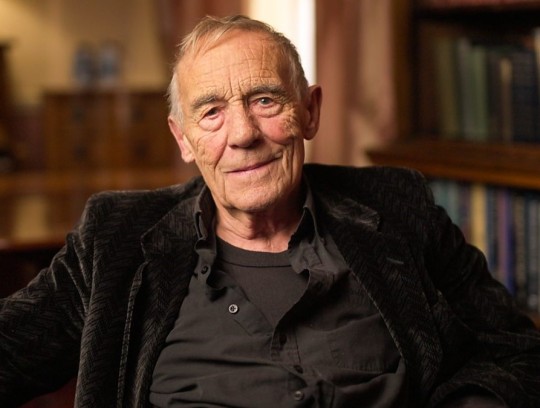
The actor Michael Jayston, who has died aged 88, was a distinguished performer on stage and screen. The roles that made his name were as the doomed Tsar Nicholas II of Russia in Franklin Schaffner’s sumptuous account of the last days of the Romanovs in Nicholas and Alexandra (1971), and as Alec Guinness’s intelligence minder in John Le Carré’s Tinker Tailor Soldier Spy on television in 1979. He never made a song and dance about himself and perhaps as a consequence was not launched in Hollywood, as were many of his contemporaries.
Before these two parts, he had already played a key role in The Power Game on television and Henry Ireton, Cromwell’s son-in-law, in Ken Hughes’s fine Cromwell (1969), with Richard Harris in the title role and Guinness as King Charles I. And this followed five years with the Royal Shakespeare Company including a trip to Broadway in Harold Pinter’s The Homecoming, in which he replaced Michael Bryant as Teddy, the brother who returns to the US and leaves his wife in London to “take care of” his father and siblings.
Jayston, who was not flamboyantly good-looking but clearly and solidly attractive, with a steely, no-nonsense, demeanour and a steady, piercing gaze, could “do” the Pinter menace as well as anyone, and that cast – who also made the 1973 movie directed by Peter Hall – included Pinter’s then wife, Vivien Merchant, as well as Paul Rogers and Ian Holm.
Jayston had found a replacement family in the theatre. Born Michael James in Nottingham, he was the only child of Myfanwy (nee Llewelyn) and Vincent; his father died of pneumonia, following a serious accident on the rugby field, when Michael was one, and his mother died when he was a barely a teenager. He was then brought up by his grandmother and an uncle, and found himself involved in amateur theatre while doing national service in the army; he directed a production of The Happiest Days of Your Life.
He continued in amateur theatre while working for two years as a trainee accountant for the National Coal Board and in Nottingham fish market, before winning a scholarship, aged 23, to the Guildhall School of Music and Drama in London, where he was five years older than everyone else on his course. He played in rep in Bangor, Northern Ireland, and at the Salisbury Playhouse before joining the Bristol Old Vic for two seasons in 1963.
At the RSC from 1965, he enjoyed good roles – Oswald in Ghosts, Bertram in All’s Well That Ends Well, Laertes to David Warner’s Hamlet – and was Demetrius in Hall’s film of A Midsummer Night’s Dream (1968), with Warner as Lysander in a romantic foursome with Diana Rigg and Helen Mirren.
But his RSC associate status did not translate itself into the stardom of, say, Alan Howard, Warner, Judi Dench, Ian Richardson and others at the time. He was never fazed or underrated in this company, but his career proceeded in a somewhat nebulous fashion, and Nicholas and Alexandra, for all its success and ballyhoo, did not bring him offers from the US.
Instead, he played Charles Lutwidge Dodgson (Lewis Carroll) in Alice’s Adventures in Wonderland (1972), a so-so British musical film version with music and lyrics by John Barry and Don Black, with Michael Crawford as the White Rabbit and Peter Sellers the March Hare. In 1979 he was a colonel in Zulu Dawn, a historically explanatory prequel to the earlier smash hit Zulu.
As an actor he seemed not to be a glory-hunter. Instead, in the 1980s, he turned in stylish and well-received leading performances in Noël Coward’s Private Lives, at the Duchess, opposite Maria Aitken (1980); as Captain von Trapp in the first major London revival of The Sound of Music at the Apollo Victoria in 1981, opposite Petula Clark; and, best of all, as Mirabell, often a thankless role, in William Gaskill’s superb 1984 revival, at Chichester and the Haymarket, of The Way of the World, by William Congreve, opposite Maggie Smith as Millamant.
Nor was he averse to taking over the leading roles in plays such as Peter Shaffer’s Equus (1973) or Brian Friel’s Dancing at Lughnasa (1992), roles first occupied in London by Alec McCowen. He rejoined the National Theatre – he had been Gratiano with Laurence Olivier and Joan Plowright in The Merchant of Venice directed by Jonathan Miller in 1974 – to play a delightful Home Counties Ratty in the return of Alan Bennett’s blissful, Edwardian The Wind in the Willows in 1994.
On television, he was a favourite side-kick of David Jason in 13 episodes of David Nobbs’s A Bit of a Do (1989) – as the solicitor Neville Badger in a series of social functions and parties across West Yorkshire – and in four episodes of The Darling Buds of May (1992) as Ernest Bristow, the brewery owner. He appeared again with Jason in a 1996 episode of Only Fools and Horses.
He figured for the first time on fan sites when he appeared in the 1986 Doctor Who season The Trial of a Time Lord as Valeyard, the prosecuting counsel. In the new millennium he passed through both EastEnders and Coronation Street before bolstering the most lurid storyline of all in Emmerdale (2007-08): he was Donald de Souza, an unpleasant old cove who fell out with his family and invited his disaffected wife to push him off a cliff on the moors in his wheelchair, but died later of a heart attack.
By now living on the south coast, Jayston gravitated easily towards Chichester as a crusty old colonel – married to Wendy Craig – in Coward’s engaging early play Easy Virtue, in 1999, and, three years later, in 2002, as a hectored husband, called Hector, to Patricia Routledge’s dotty duchess in Timberlake Wertenbaker’s translation of Jean Anouilh’s Léocadia under the title Wild Orchids.
And then, in 2007, he exuded a tough spirituality as a confessor to David Suchet’s pragmatic pope-maker in The Last Confession, an old-fashioned but gripping Vatican thriller of financial and political finagling told in flashback. Roger Crane’s play transferred from Chichester to the Haymarket and toured abroad with a fine panoply of senior British actors, Jayston included.
After another collaboration with Jason, and Warner, in the television movie Albert’s Memorial (2009), a touching tale of old war-time buddies making sure one of them is buried on the German soil where first they met, and a theatre tour in Ronald Harwood’s musicians-in-retirement Quartet in 2010 with Susannah York, Gwen Taylor and Timothy West, he made occasional television appearances in Midsomer Murders, Doctors and Casualty. Last year he provided an introduction to a re-run of Tinker Tailor on BBC Four. He seemed always to be busy, available for all seasons.
As a keen cricketer (he also played darts and chess), Jayston was a member of the MCC and the Lord’s Taverners. After moving to Brighton, he became a member of Sussex county cricket club and played for Rottingdean, where he was also president.
His first two marriages – to the actor Lynn Farleigh in 1965 and the glass engraver Heather Sneddon in 1970 – ended in divorce. From his second marriage he had two sons, Tom and Ben, and a daughter, Li-an. In 1979 he married Ann Smithson, a nurse, and they had a son, Richard, and daughter, Katie.
🔔 Michael Jayston (Michael James), actor, born 29 October 1935; died 5 February 2024
Daily inspiration. Discover more photos at Just for Books…?
13 notes
·
View notes
Text
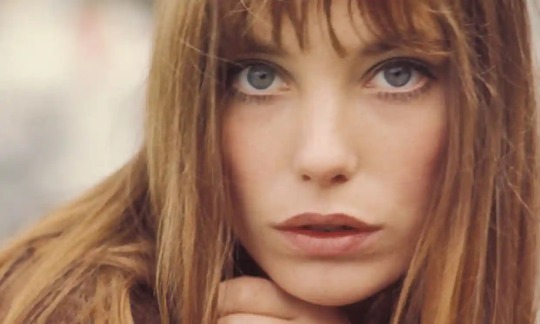
Jane Birkin, actor and singer, dies aged 76
Best known for the sexually explicit 1969 hit Je t’aime … moi non plus, she found fame in her adopted France
The British-born actor and singer Jane Birkin has been found dead at her home in Paris, the French culture ministry said on Sunday.
Birken, 76, was best known overseas for her 1969 hit in which she and her lover, the late French singer-songwriter Serge Gainsbourg, sang the sexually explicit Je t’aime … moi non plus.
Birkin found fame in her adopted France, catapulted into the public eye by her turbulent relationship with Gainsbourg. Her heavily accented French became her personal style signifier.
She crossed the channel in 1968 at the age of 22 to star in a film alongside Gainsbourg, who was 18 years her senior. It was the start of a 13-year relationship that made them France’s most famous couple, in the spotlight as much for their bohemian and hedonistic lifestyle as for their work.
The doe-eyed Birkin, with her soft voice and androgynous silhouette, quickly became a sex symbol, recording the steamy Je t’aime … moi non plus with a growling Gainsbourg. Banned on radio in several countries and condemned by the Vatican, the song was a worldwide success.
“He and I became the most famous of couples in that strange way because of Je t’aime and because we stuck together for 13 years and he went on being my friend until the day he died. Who could ask for more?” Birkin told CNN in 2006.
“So Paris became my home. I’ve been adopted here. They like my accent,” she said.
Birkin was born in London on 14 December 1946 to an actor mother and naval officer father. At 17, she married the James Bond composer John Barry, with whom she had a daughter, Kate, but the marriage lasted only three years.
She made waves in her film debut in 1966 with a full frontal nude scene in the swinging sixties classic Blow-Up by Michelangelo Antonioni.
After meeting Gainsbourg, 18 years her senior, in Paris on the set of a romantic comedy – he was her co-star – she moved to France permanently. Their musical and romantic relationship was tempestuous. During one of their raging rows, Birkin launched herself into the River Seine after throwing a custard pie in Gainsbourg’s face.
They had a daughter, Charlotte, who became a hugely successful actor and singer.
Birkin finally walked out on France’s favourite bad boy in 1980 and went on to to blaze her own trail. In cinema, she branched out from more ditsy roles to arthouse productions, gaining three nominations at the Césars – France’s Oscars – starting with La Pirate in 1985.
In her about 70 films she has been directed by France’s leading directors, including Bertrand Tavernier, Jean-Luc Godard, Alain Resnais, James Ivory and Agnès Varda.
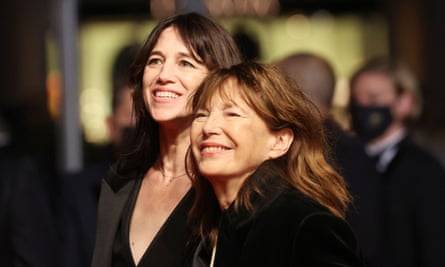
A chronic alcoholic, Gainsbourg died of a heart attack in 1991 aged 62. A few years earlier, he was in the audience to hear Birkin perform her first solo concert at the age of 40 at the Bataclan theatre in Paris.
In 1998 came her first record without Gainsbourg, Á la Légère. But she repeatedly returned to his repertoire, singing his hits around the world accompanied by a full orchestra, including in 2020 in New York where she performed with Iggy Pop.
The English rose of French chanson became something of a national treasure, who preserved the accent that made the French swoon throughout her life and an endearing air of fragility.
Her life was marked by tragedy, with her eldest daughter Kate Barry, a photographer, apparently committing suicide in 2013. She had leukaemia in the late 1990s and in 2021 suffered a minor stroke.
With her flared jeans, mini-dresses and messy bangs, Birkin was the ultimate It girl in the 1970s. In 1984, Hermès named one of its handbags after her. She was made an Officer of the Order of the British Empire (OBE) in 2001 for her services to acting and British-French cultural relations.
Besides Charlotte and Kate, she had another daughter, the singer Lou Doillon, from her 13-year relationship with the French director Jacques Doillon.
RIP Jane
26 notes
·
View notes
Text

"Let our men take a rest, Easy chores are what we best At, indeed.
There are a thousand reasons why Me must save our dearest guys For the real deeds, for the biggest deeds."
(my attempt in translating the song from Russian)
In 2024, two-part Soviet musical film «Summer Vacation of Petrov and Vasechkin, Unremarkable and Unbelievable», released on TV July 28 and 29 in 1984, turns 40 years.
This is one of my favorite children movies, romantic summer fantasia with engaging songs, and I wanted to celebrate its anniversary by drawing my favorite character from it, cool Georgian (and Miyazakian in spirit!) grandma portrayed by Sofiko Chiaureli.

40 лет назад, 28 и 29 июля, по советскому ТВ впервые был показан музыкальн��й фильм «Каникулы Петрова и Васечкина, обыкновенные и невероятные». Эта романтическая летняя фантазия с очаровательными песнями – один из моих любимых детских фильмов. Фанарт посвящается моему любимому персонажу фильма – грузинской (миядзаковской по духу!) бабушке в исполнении Софико Чиаурели.
youtube
#каникулы петрова и васечкина#soviet cinema#советское кино#soviet cinema fanart#traditional art#phantieart
4 notes
·
View notes
Text
Recent hateration and holleration:
BEVERLY HILLS COP: AXEL F (2024): Geriatric latter-day revival of Eddie Murphy's action-comedy franchise is the best of the three COP sequels (no great achievement), but there's no reason for it to exist other than money, and it's so determined to replicate the beats of the 1984 movie that it even reuses several of its hit songs. Eddie Murphy returns to the streetwise wiseass humor that originally made him a star, but it now feels pretty stale, he's too old for this kind of thing, and the inevitable appearances of his original costars (Paul Reiser, Judge Reinhold, John Ashton, and Bronson Pinchot, though curiously not Ronny Cox) are further reminders that the elements that made the original entertaining were, shall we say, of their time. Taylour Paige is appealing as Axel's estranged daughter Jane, but an already flaccid story is further deflated by the casting of Joseph Gordon-Levitt, dreary as Jane's cop ex-boyfriend. Why Gordon-Levitt's character is in this movie at all is unclear; it felt like much of the role might have originally been written for Reinhold (who's absent through much of the story), but was split into a separate character because the producers got nervous about not having at least one male lead under 60. Gordon-Levitt isn't much of an action star, he has no flair for this kind of comedy, his chemistry with Murphy is nonexistent, and his supposed romantic chemistry with Paige barely rises to the "awkward handshake" level. Kevin Bacon, playing a villainous corrupt cop, is the only one who seems to be having fun, but the movie gives him precious little to work with. CONTAINS LESBIANS? Nah. VERDICT: Not unbearably awful as these things go, but the stench of desperation is hard to ignore. If you're tempted, just watch the original.
SPACE CADET (2024): Charmingly silly comedy, written and directed by Liz W. Garcia, about plucky Florida bartender and sometimes alligator wrestler Rex Simpson (Emma Roberts), who never got to go to college, scamming her way into the NASA astronaut candidacy program with the help of her friend Nadine (Poppy Liu) — who also pretends to be all of Rex's references, baffling the program's hunky deputy director Logan O'Leary (Tom Hopper), who's becoming a little sweet on Rex. Along the way, Rex and nerdy fellow AsCan Violet (Kuho Verma) help each other out, and Rex finds she might have a real flair for it after all. The story doesn't always pay off its amusing setups as well as it might, and credibility is obviously not a high point, but it's cute and funny, and Roberts is a delight. CONTAINS LESBIANS? There's a throwaway line or two suggesting that Violet is bisexual, but that's about it. VERDICT: Contrived but appealing, a movie I would have adored when I was about 12.
#movies#hateration holleration#beverly hills cop#axel foley#beverly hills cop axel f#eddie murphy#taylour paige#joseph gordon levitt#kevin bacon#space cadet#liz w garcia#emma roberts#poppy liu#kuho verma#the original beverly hills cop is fun in a turn-off-your-brain way#but its '80s formula of over-the-top violence and “funny foreigner” gags#plus some snotty '80s homophobia#is not a formula that really works now#i actually really like the beverly hills cop soundtrack#i love the pointer sisters#but reusing *several* of the songs from the first two movies feels desperate#it's like a remake except the jokes aren't funny and everyone is 40 years older
2 notes
·
View notes
Photo
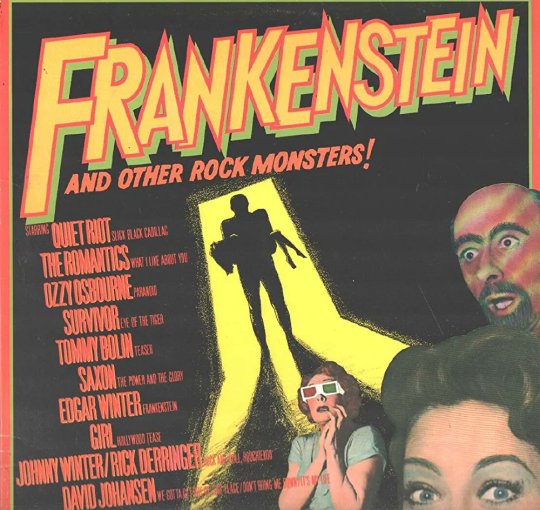
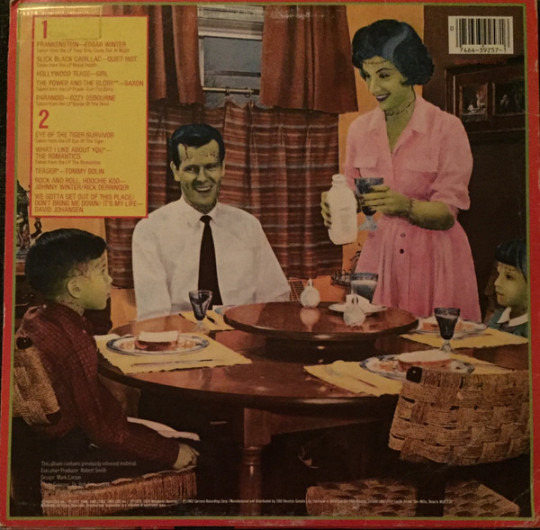
Today’s compilation:
Frankenstein and Other Rock Monsters 1984 Hard Rock / Heavy Metal / Blues-Rock
Don't be fooled by the title or the packaging, folks; this may look like some cheap, little Halloween or horror-themed comp, but it's very much not. The brain trust at CBS Records just decided to make Edgar Winter's classic 1973 prog rock instrumental, "Frankenstein," this album's title track, and then proceeded to extrapolate on a purely aesthetic theme from there.
What this really is, is just a short sampler of hard rock and heavy metal tunes from the 70s and 80s that were in CBS' catalogue at the time in 1984, when this LP was originally released. And I gotta say, with such a broad theme, that I kinda dig the whole randomness of this album's selections; it's not like it's making some silly, grandiose claim of "best rock songs" that it's sure to fall short of in just 40-plus minutes of runtime. Instead, Frankenstein and Other Rock Monsters is just fully cognizant of what it is, with really no set expectations to meet; and that's kind of refreshing.
So, what we have is an assorted mix of different classic rock things: there's some *very* overplayed classics, like the aforementioned title track, Survivor's "Eye of the Tiger," and The Romantics' "What I Like About You;" some pretty blasé heavy metal tunes; and a couple throwaway live recordings from Ozzy Osbourne and David Johansen, although the guitar solo on Ozzy's "Paranoid" is pretty gnarly.
But there's two other songs on here that end up making this whole listening experience worth it in the end. And both of them never charted, but they happen to sit back-to-back on this album's b-side: Tommy Bolin's "Teaser" and Johnny Winter's "Rock and Roll, Hoochie Koo."
Tommy Bolin's 1975 solo debut album was actually critically acclaimed when it came out, but it didn't really succeed commercially, and that's because Bolin had caught himself in a bit of his own little pickle. See, Ritchie Blackmore had just quit Deep Purple and the remaining members were trying to figure out if they should just fully dissolve the band or try to find a replacement. But Bolin then ended up jamming with them for a few hours and they instantly decided to keep on chugging along with him as their lead guitarist. As a result, Bolin now had tour commitments to the band and couldn't support his own solo effort, which was released around the same time as Deep Purple's newest album. It was a real shame too, because the Beach Boys had even coached him on how to sing and he had brought in some real talent to back him on the studio recordings as well, including synth wizard Jan Hammer, famed saxophonist David Sanborn, and even Phil Collins. None of them appeared on the album's title track, though, which is still a terrific piece of mid-70s hard rock 🤘 .
And regarding "Rock and Roll, Hoochie Koo," there's a definite chance that you've heard a different version of it before; one that was by Rick Derringer that turned out to be his only top-40 solo hit, reaching #23 on Billboard's Hot 100 in 1973. But that wasn't actually the original version of the song, despite the fact that Derringer himself had written it. In 1970, he was a member of a band called Johnny Winter And, and naturally, they ended up being the first ones to record it. So, it's not the most famous version of the song, but it's still a great piece of somewhat overlooked Johnny Winter-branded blues-rock 😎.
All in all, this album was feeling like a bit of a waste of time at about three-quarters of the way in, but then CBS put in that pair of relative obscurities from Bolin and Winter, and that ended up changing the overall dynamic of the whole album. Was bored by rote classics and mediocre metal, but those two songs managed to enhance the overall listen by a good margin 🙂.
Highlights:
Edgar Winter - "Frankenstein" Survivor - "Eye of the Tiger" Romantics - "What I Like About You" Tommy Bolin - "Teaser" Johnny Winter - "Rock and Roll, Hoochie Koo"
#hard rock#rock#heavy metal#metal#blues rock#classic rock#music#70s#70s music#70's#70's music#80s#80s music#80's#80's music
7 notes
·
View notes
Note
Dear future bf
✨ anonymous. meme. still accepting!
How’s the weather?
Life’s been crazy for us all and it’s made me very scared to open up, but I can’t wait to meet you. Recently, I have learned to not run away from my pain and trauma. I’m sitting in it and letting it process and pass—even if it stings, sometimes. I learned that I need to move toward the pain. Pain doesn’t go away. If you don’t embrace it, it will be passed onto someone else, usually those around you. So, when we finally meet, I’ll be collected enough to not pass that baggage onto you. ♡ When we meet, I won’t be my best self. We’re never our best selves because we change every single day. But, I’ll be a version of myself that doesn’t walk in to love with paranoia sitting on my shoulders.
I want you to meet me with a sense of self that wants to keep improving, too. ♡ We’ll grow together, it’ll be really great. You don’t have to be whole and confident and sure when we finally find each other. I don’t expect that from you. It’s not: I love you no matter which of my expectations you meet or don’t meet. It’s: My only expectation is that you become yourself. The more deeply I learn you and who you are as a person, the more wonderful and beautiful you become to me.
That’s all. I love you, whoever you are and wherever you are. I can’t wait for your body to fill my arms and welcome you home. Be safe, take care, and keep warm. Or, cool. Depends on where you are! Perhaps, I don’t have much to offer. I really don’t know, I’ve never analyzed myself like that; but, I do want you to know that you have security with me and a warm place to sit. Our relationship will be a worn out, quirky, cozy couch on the penthouse rooftop. Right by my side. I’m waiting for you.
I hope you’re waiting for me, too. Ever imagined things we could do? Slow dancing to Junko Yagami. Her song, 1984. I can almost feel your hand on the small of my back, pulling me closer as we dance cheek-to-cheek. But, I’m so short... It’ll probably be cheek-to-chest. I’m sure you’re probably a lot taller than I am ( I do like ‘em tall. ) Anyway, just something to think about.
You know, I’m usually never this sentimental or romantic. Don’t worry, I’ll balance it out by complaining often and being generally unpleasant to be around while shopping at Whole Foods because I become an angry beast when confronted by all of the artisanal soaps they have on display. Staff don’t really like the fact that I pick up every single bar and press it to my nose.
Apparently, that scares the other customers.
♡ Virote.
P.S. Do you like indie films? Write back, tell me.
3 notes
·
View notes
Note
prompts for aurelia please 💗 thank you!!
SONGS ON AURELIA ROOKWOOD'S MIXTAPE COULD BE...
"I don't give a damn 'bout my reputation. Living in the past, it's a new generation. A girl can do what she wants to do and that's what I'm gonna do." - Bad Reputaion, Joan Jett & the Blackhearts (1980) [x]
A bad girl seemingly without a cause, Aurelia gained a bit of a reputation as a bully at school which has translated into her adult life working at Witch Weekly. You could explore Aurelia's earlier years in her sample and think of her rivalries with certain girls at school. You could even use her childhood as a flashback and consider how she has rather changed ot stayed the same in her adult life. Is she still just as cutting? Have her ways of opperating gotten more sneaky or is she still very much in your face with how rude or abrupt she is with those she doesn't deem useful to her?
"A goddess on a mountain top. Was burning like a silver flame. The summit of beauty and love. And Venus was her name." - Venus, Bananarama (1986) [x]
Aurelia realised late into her teenage years she had a certain power over men, you could stage your sample during a time where she first noticed this or when it came in handy. Perhaps it was her first time trying to get a job at Witch Weekly or how at school she could convince CAIUS BURKE [close friend/former partner/potential romantic liaison/] or KERVENS BORGIN [best friend/potential romantic liaison] to do whatever she wanted. Consider how Aurelia feels about having this power and how it has its upsides and perhaps its downsides also.
"Some people work for a living. Some people work for fun. Girl, I just work for you. They told me marriage was a give-and-take. Well, you've shown me you can take, you've got some giving to do." - Everything She Wants, Wham (1984) [x]
To everyone outside of their relationship, Aurelia's relationship with AJAX DAVIS [partner] is toxic. How does it feel to Aurelia? Is she aware of all the bad things she does to him and how does it make her feel? Does she truly love Ajax or is he a means to an end or even worse, something to play with when she gets bored? You could stage your sample during a time she considers this, a date they are having, a heated argument or maybe discussing it with a friend like EMMA SQUIGGLE [friend] over a few drinks.
#marauders rp#marauders rpg#marauders era roleplay#marauders roleplay#harry potter rp#prompts#p aurelia rookwood
1 note
·
View note
Text
Shreya Ghoshal’s Global Impact: Taking Indian Music to the World
Shreya Ghoshal is a name that resonates with every music lover, not just in India but worldwide. With her soulful voice and an ability to deliver emotions through her singing, Shreya has become one of the most celebrated playback singers in Indian music. From being a small-town girl with dreams of making it big to becoming a global icon, her journey is nothing short of inspiring. This article delves into the incredible evolution of Shreya Ghoshal, exploring the milestones, challenges, and triumphs that have defined her remarkable career.
The Early Years: A Prodigy in the Making
Born on March 12, 1984, in Berhampore, West Bengal, Shreya was destined for musical greatness. Her family recognized her talent early on, and by the age of four, she was already being trained in classical music. Growing up in Rawatbhata, Rajasthan, she imbibed a love for traditional Indian music, which would later become the foundation of her versatile singing style.
Shreya’s parents played a pivotal role in nurturing her talent. Her mother often practiced with her, while her father, an engineer by profession, ensured she had the best training. She studied under her first guru, Mahesh Chandra Sharma, where she honed her classical skills and competed in numerous local competitions.
The Turning Point: Reality TV Success
Shreya’s life changed forever when she participated in the television reality show Sa Re Ga Ma Pa at the age of 16. Her soulful renditions on the show caught the attention of filmmaker Sanjay Leela Bhansali, who was looking for a fresh voice for his upcoming movie Devdas. Her performance on the show was so impactful that Bhansali personally reached out to her and offered her the opportunity to be the voice of Paro.
This was a defining moment for Shreya. The songs from Devdas, including “Bairi Piya,” “Dola Re Dola,” and “Silsila Ye Chahat Ka,” catapulted her to instant fame. She not only won the National Film Award for Best Female Playback Singer but also proved her mettle as a versatile and emotive singer. The film’s soundtrack remains iconic to this day, with Shreya’s voice as one of its standout features.
Establishing Herself in Bollywood
Post-Devdas, Shreya became a household name, and there was no looking back. She worked with some of the most prominent music directors, including A.R. Rahman, Pritam, and Vishal-Shekhar. Her ability to adapt to various musical styles, whether it was a classical piece or a contemporary track, made her a favorite among composers.
Songs like “Jaadu Hai Nasha Hai” (Jism), “Teri Ore” (Singh Is Kinng), “Piyu Bole” (Parineeta), and “Sun Saathiya” (ABCD 2) further established her as a versatile artist capable of delivering hits across genres. Whether it was romantic ballads, peppy dance numbers, or soulful ghazals, Shreya’s voice became synonymous with perfection.
Conquering Regional and Global Music
One of Shreya’s unique qualities is her ability to sing in multiple languages. Over the years, she has sung in more than 20 Indian languages, including Bengali, Tamil, Telugu, Kannada, Marathi, and Malayalam. Her linguistic versatility has endeared her to audiences across India, making her one of the most sought-after playback singers in the industry.
Her global appeal was recognized when the state of Ohio, USA, declared June 26 as Shreya Ghoshal Day in 2010. This acknowledgment was not just a testament to her talent but also to her role in representing Indian music on the global stage.
Adapting to Changing Trends
As the music industry evolved with the advent of streaming platforms and independent music, Shreya adapted seamlessly. While she continues to dominate as a playback singer, she has also ventured into independent music projects. Her singles, such as “Tere Bina” and “Angana Morey,” showcase her versatility and willingness to explore new territories.
Shreya’s live performances have also become a significant aspect of her career. Her concerts, both in India and abroad, are known for their energy, emotion, and connection with the audience. These performances allow her fans to experience her magic in a more personal and intimate setting.
Accolades and Legacy
Shreya Ghoshal’s illustrious career is adorned with numerous accolades, including four National Film Awards, seven Filmfare Awards, and several state awards. She has consistently been featured in Forbes India’s Celebrity 100 list, highlighting her influence in the entertainment industry.
However, her most significant achievement lies in the hearts of her fans. Her voice has been a constant companion for millions, accompanying them through moments of joy, love, heartbreak, and nostalgia.
Conclusion: An Enduring Icon
Shreya Ghoshal evolution from a small-town girl to a global music icon is a story of talent, perseverance, and passion. Her ability to adapt to changing times while staying true to her classical roots has made her a timeless figure in the world of music.
Even after two decades in the industry, Shreya continues to inspire young musicians and bring joy to her listeners. Her journey is a testament to the fact that with talent, hard work, and dedication, dreams can indeed come true.
To experience the magic of Shreya Ghoshal’s voice, explore her discography on platforms like Spotify, Apple Music, and YouTube. Follow her on social media to stay updated on her latest projects, and don’t miss the chance to attend her live performances for an unforgettable experience. Let her music inspire and accompany you on your journey through life.
0 notes
Text
09/11/24 Mondo Radio Playlist
Here's the playlist for this week's edition of Mondo Radio, which you can download or stream here. This episode: "Out Past Midnight", featuring classic power pop and more. If you enjoy it, be sure to also follow the show on Facebook and Twitter!
Artist - Song - Album
Cheap Trick - Hello There (Live) - Cheap Trick At Budokan
Nick Gilder - Frustration - City Nights
Raspberries - I Don't Know What I Want - Greatest
Nick Gilder - Got To Get Out - City Nights
Cheap Trick - Down On The Bay (Live) - Raising Hell: The 1970s
Rock City Feat. Chris Bell - Think It's Time To Say Goodbye - Looking Forward: The Roots Of Big Star
Big Star - In The Street - #1 Record
Alex Chilton - Can't Seem To Make You Mine - 19 Years: A Collection Of Alex Chilton
Big Star - O My Soul - Radio City
The Scruffs - She Say Yea - Wanna' Meet The Scruffs?
Flamin' Groovies - Shake Some Action - Shake Some Action
Dwight Twilley Band - Three Persons - On Fire!: The Best Of 1975-1984
Todd Rundgren - Couldn't I Just Tell You - Something/Anything?
Single Bullet Theory - There Is The Boy - SBT: 1977-1980
Borinquen - Himno De Los E.U.A - Temas Para Recordar …
The Nerves - When You Find Out - 25th Anniversary
The Nerves - Give Me Some Time - 25th Anniversary
The Romantics - Till I See You Again - The Romantics
The Romantics - Girl Next Door - The Romantics
The Wigs - 180 Degrees - Radio Ready: Wisconsin - Lost Power Pop Hits 1979-1982
The Tyrants - Hard To Get - Radio Ready: Wisconsin - Lost Power Pop Hits 1979-1982
The Baxters - What Ya Gonna Do - History In 3 Chords: Milwaukee Alternative Bands 1973-1982
The RPMs - I Don't Wanna Be Young - History In 3 Chords: Milwaukee Alternative Bands 1973-1982
The Shivvers - Please Stand By - Lost Hits From Milwaukee's First Family Of Powerpop: 1979-82
The Shivvers - Teen Line - Lost Hits From Milwaukee's First Family Of Powerpop: 1979-82
M&Ms - I'm Tired - The Roots Of Powerpop
Real Kids - Now You Know - The Roots Of Powerpop
Shoes - Tomorrow Night - Present Tense
Shoes - Too Late - Present Tense
The Records - Rumour Sets The Woods Alight - Crashes
The Spongetones - She Goes Out With Everybody - Children Of Nuggets: Original Artyfacts From The Second Psychedelic Era 1976-1996
The Barracudas - I Can't Pretend - Children Of Nuggets: Original Artyfacts From The Second Psychedelic Era 1976-1996
The Records - The Same Mistakes - Crashes
The dB's - Judy - Stands For Decibels
The dB's - I'm In Love - Stands For Decibels
20/20 - Yellow Pills - 20/20
20/20 - Tell Me Why (Can't Understand You) - 20/20
The Last - Every Summer Day - L.A. Explosion!
The Last - Be-Bop-A-Lula - L.A. Explosion!
The Plimsouls - I Want What You Got - The Plimsouls … Plus
The Plimsouls - Lost Time - The Plimsouls … Plus
Green - Baby Why? - Green
Green - I Play The Records - Green
0 notes
Text
The Influence of Hollywood Music on Pop Culture
Hollywood music has always been more than just an accompaniment to the visual spectacle of films; it has been a powerful cultural force that shapes and reflects the broader currents of society. From iconic soundtracks that become ingrained in the collective consciousness to songs that inspire fashion trends and social movements, the music of Hollywood films plays a crucial role in defining and influencing pop culture. This article delves into the profound impact of Hollywood music on various aspects of pop culture, exploring how it has shaped fashion, language, social movements, and even the global music scene.
Iconic Soundtracks: Defining Generations and Cultural Moments
Hollywood has produced countless soundtracks that have transcended the films they were created for, becoming cultural landmarks in their own right. These soundtracks often capture the spirit of the times, resonating with audiences across generations and contributing to the cultural zeitgeist.
Timeless Classics: Some Hollywood soundtracks have become timeless classics, continuing to influence pop culture decades after their release. For instance, John Williams' score for "Star Wars" (1977) is not just a part of the film; it is a cultural phenomenon. The opening fanfare is instantly recognizable, evoking images of space battles and heroic quests. This soundtrack has been referenced, parodied, and celebrated in various forms of media, from TV shows to video games, solidifying its place in pop culture history.
Similarly, the soundtrack of "Titanic" (1997), composed by James Horner, became a cultural touchstone, with Celine Dion's "My Heart Will Go On" becoming one of the most iconic love ballads of all time. The song’s success went beyond the film, topping charts worldwide and becoming a staple at weddings and romantic events. The soundtrack's impact on pop culture was so profound that it continues to be associated with themes of love and tragedy, even years after the film's release.
The Rise of Pop Music in Films: The integration of pop music into Hollywood films, particularly during the 1980s and 1990s, further solidified the connection between film soundtracks and pop culture. Movies like "Footloose" (1984) and "Dirty Dancing" (1987) featured soundtracks that not only complemented the films but also became massive hits on their own. The songs from these films became anthems of the era, influencing dance styles, fashion, and even social behaviors.
One of the most significant examples of this phenomenon is the 1992 film "The Bodyguard," which featured Whitney Houston’s powerful rendition of "I Will Always Love You." The song became a global sensation, breaking records and becoming one of the best-selling singles of all time. Its influence extended beyond the film, becoming a defining moment in Houston's career and a significant cultural milestone in the 1990s.
Music and Fashion: Hollywood’s Impact on Style and Trends
Hollywood music has also had a profound influence on fashion, with soundtracks and musical performances from films often inspiring trends that resonate far beyond the cinema. From the rebellious spirit of rock 'n' roll to the glamour of disco, Hollywood has been instrumental in shaping fashion trends that define entire eras.
The Rock 'n' Roll Revolution: The rock 'n' roll era of the 1950s and 1960s brought a seismic shift in both music and fashion, with Hollywood playing a key role in popularizing the new style. Films like "Jailhouse Rock" (1957) and "A Hard Day's Night" (1964) showcased the rebellious, youthful energy of rock 'n' roll, influencing not just musical tastes but also fashion. The slicked-back hair, leather jackets, and denim jeans worn by Elvis Presley and The Beatles became emblematic of the era, symbolizing a break from the conservative fashion of the previous decade.
The influence of rock 'n' roll on fashion continued into the 1970s, with films like "Grease" (1978) and "Saturday Night Fever" (1977) further cementing the connection between music and style. "Saturday Night Fever," in particular, popularized the disco look, with John Travolta's white suit becoming an iconic symbol of the disco era. The film’s soundtrack, featuring hits by the Bee Gees, not only dominated the charts but also influenced the fashion of the time, with glittering outfits, platform shoes, and wide-collared shirts becoming staples of the disco scene.
The Punk and Grunge Movements: The punk and grunge movements of the 1970s and 1990s, respectively, also saw Hollywood films influencing fashion trends. The punk aesthetic, with its ripped clothing, safety pins, and bold hairstyles, was popularized in part by films like "The Great Rock 'n' Roll Swindle" (1980) and "Sid and Nancy" (1986), which chronicled the rise of punk icons like the Sex Pistols. The raw, rebellious energy of punk music was mirrored in the fashion of the time, with Hollywood playing a crucial role in bringing this subculture into the mainstream.
In the 1990s, the grunge movement, epitomized by bands like Nirvana and Pearl Jam, brought a more laid-back, anti-fashion aesthetic to the forefront. Films like "Singles" (1992), which featured music by prominent grunge bands, showcased the grunge look: flannel shirts, ripped jeans, and combat boots. This casual, unpolished style became a defining fashion trend of the 1990s, influencing not just youth culture but also high fashion, with designers like Marc Jacobs incorporating grunge elements into their collections.
Social Movements: How Hollywood Music Fuels Change
Hollywood music has not only influenced fashion and culture but has also played a significant role in social movements. Songs from films often resonate with the broader social and political context, inspiring activism and change.
Civil Rights and Protest Music: The civil rights movement of the 1960s saw a surge in protest music, much of which was featured in Hollywood films. Movies like "The Graduate" (1967), which featured Simon & Garfunkel's "The Sound of Silence," and "Easy Rider" (1969), with its countercultural soundtrack, became emblematic of the era's social upheaval. These soundtracks captured the spirit of rebellion and the desire for change, providing a musical backdrop to the protests and demonstrations of the time.
The 1980s and 1990s continued this tradition, with films like "Do the Right Thing" (1989) and "Malcolm X" (1992) featuring soundtracks that addressed issues of race, inequality, and social justice. Public Enemy’s "Fight the Power," featured in "Do the Right Thing," became an anthem for the fight against racial injustice, with its powerful lyrics and aggressive beat resonating with audiences far beyond the film.
Environmental and Feminist Movements: Hollywood music has also played a role in environmental and feminist movements. Films like "Thelma & Louise" (1991) and "Erin Brockovich" (2000) featured soundtracks that empowered women, with songs that became anthems for feminist activism. The soundtrack of "Thelma & Louise," with its mix of country, rock, and blues, reflected the film’s themes of freedom and resistance, inspiring a generation of women to challenge societal norms.
In recent years, films like "An Inconvenient Truth" (2006) have used music to draw attention to environmental issues. The film’s soundtrack, featuring Melissa Etheridge’s "I Need to Wake Up," won an Academy Award and became a rallying cry for environmental activism. This use of music to promote social and environmental causes highlights the power of Hollywood music to inspire change and galvanize public support for important issues.
Global Reach: Hollywood Music as a Cultural Export
Hollywood music has not only influenced pop culture within the United States but has also had a profound impact globally. The international reach of Hollywood films has helped spread American music and culture around the world, creating a shared cultural experience that transcends national boundaries.
The Spread of American Pop Culture: Hollywood films have long been a vehicle for exporting American pop culture to the rest of the world. From jazz and blues in the early 20th century to rock 'n' roll and hip-hop in the latter half, Hollywood soundtracks have introduced global audiences to various American music genres. This cultural export has had a significant impact on music scenes in other countries, with artists around the world drawing inspiration from Hollywood soundtracks.
For instance, the global success of "Saturday Night Fever" in the 1970s helped popularize disco music in countries like the United Kingdom, Germany, and Japan. Similarly, the rock 'n' roll soundtracks of the 1950s and 1960s influenced the development of music scenes in Europe, leading to the rise of bands like The Beatles, who would later influence Hollywood soundtracks themselves.
Cross-Cultural Collaborations: In recent years, Hollywood music has increasingly reflected the global nature of the film industry, with cross-cultural collaborations becoming more common. Films like "Slumdog Millionaire" (2008) and "Black Panther" (2018) featured soundtracks that blended Western and non-Western musical styles, showcasing the diversity of global music cultures.
The soundtrack of "Slumdog Millionaire," composed by A.R. Rahman, combined traditional Indian music with contemporary electronic elements, earning international acclaim and winning multiple awards, including the Academy Award for Best Original Score. This fusion of musical styles not only enhanced the film’s narrative but also introduced global audiences to Indian music, further illustrating the power of Hollywood music as a cultural bridge.
Collaborations with Global Artists: Hollywood has also collaborated with international artists to create soundtracks that resonate with global audiences. For example, the "Fast & Furious" franchise has featured music by artists from around the world, reflecting the diverse cast and global appeal of the films. These collaborations have helped Hollywood soundtracks reach new markets and connect with audiences from different cultural backgrounds.
Moreover, the rise of streaming services has made Hollywood music more accessible to global audiences, allowing listeners from different countries to discover and enjoy soundtracks that they might not have encountered otherwise. This increased accessibility has further strengthened the influence of Hollywood music on global pop culture.
Conclusion
Hollywood music has played a crucial role in shaping and reflecting pop culture, influencing everything from fashion and language to social movements and global music trends. The iconic soundtracks of Hollywood films have become cultural landmarks, defining generations and inspiring change. As Hollywood continues to evolve and embrace new musical styles and technologies, its music will undoubtedly continue to have a profound impact on pop culture, both in the United States and around the world.
0 notes
Text
40 years of “La Voz de los 80’”: How some of its topics still (unfortunately) persist on today’s world and today’s Chile
In Chile, there are few bands or artists more influential and important than Los Prisioneros. With their decade-spanning influence, they are considered one of the most important artists or band to come out of Chile. They made their debut album in 1984, “La Voz de los 80’”, and followed with three classic albums: “Pateando Piedras”, “La Cultura de la Basura” and “Corazones” before disbanding. What really set them apart from other bands of the era was the simplicity of their proposal. They were pretty much just regular guys. They weren’t a fancy, staged or technically proficient band, rather basing their musical proposal in the authenticity preached by bands like The Clash, letting the music, the lyrics and the message speak for themselves.
“La Voz de los 80’”, as their debut, represents their first work, but also one of their very best. From a musical standpoint, it combines elements of punk, new wave, pop, latín, reggae and ska. Anyone familiar with Los Prisioneros’s music is aware of the messages and topics they touch in their music. With the exception of “Corazones”, lyrically they have always taken a critical approach towards the political and social issues and ideas that affected them, In this process, people just like them ended up identifying with them, embracing their message. “La Voz de los 80´” represents their first approach towards this audience of people.
“La Voz de los 80’” opens with its title track, a wake up call that regards the inertia and indifference felt by the youth of the 70’s towards the issues that came with the establishment of the (then) new hegemonic global models by the Northern powers, such as industrialization, comercialization and stagnation.
In a similar note, the following track “Brigada de Negro” talks about how youth over- eliance and dependence on partying and substance abuse. More than a pretentious or high morality stance, it specifically talks about the over-reliance on drugs to feel fullfilled or happy, bordering on functional addiction, and tending to overlooking the important issues that directly affect them.
“Latinoamérica es un pueblo al sur de Estados Unidos”, a ska charged with a latin-american pride, talks about Latin America´s historical role as USA’s “backyard” and its treatment by the Northern Powers, such as USA., NATO and the USSR. This song touches on issues like extractivism, war financing, economic liberalization and privatization, socio-economic injustice and the inferiority complex felt as a continent.
“Eve-Evelyn” is the 4th track, and is an outlier from a sound and a lyrical standpoint. It’s a love song and the band’s first experimentation with the electronic sounds that they would develop later on their carreer.
“Sexo” speaks about how the sexualization of commercialization affects the youth’s standards, expectations and ideas towards sexual and interpersonal relationships, and how aware of this, the companies on charge use sexuality as a deal to sell.
“¿Quién Mató a Marilyn?”, a more punk influenced track, is a parody song that speaks about media manipulation, using the figure and death of Marilyn Monroe. Along the song, they constantly accuse in a jokingly manner several people and institutions about killing Marilyn Monroe.
“Paramar” touches on the romanticized idea of love and the feeling of pretentiousness and having to pretend to be something you’re not in order to fit and being able to find a romantic partner.
“No Necesitamos Banderas” is a reggae number that again touches on the topic of latin-american pride, this time from an international stance, advocating for a united Latin America, without borders and reconizing that we have as much similarities as we have differences.
“Mentalidad Televisiva” talks about how media (TV) influences the youth’s mentality towards romantic relationnships, creating unrealistic expectations and standards.for their romantic partners because of the influence TV has on young people, affecting their mentality.
Finally, “Nunca Quedas Mal con Nadie”, a ska number, talks about how often spokesmen for social and political issues tend to take these roles just to gain notoriety and feed their own egos, in the end failing at their task as they decide to not stand up for these causes, or compromising them to please every party involved.
Even though the majority of the issues the band talked about on the album are still present in some shape or form, there´s specifically three topics that still resonate strongly to this day: the injustice towards Latin America, the manipulation by the media and the creation of unrealistic, unhealthy standards by media.
Latin America has historically served the interests of the Northern Powers, sacrificing its resources, people, manpower, cities and territories to satisfy their demands. During the 80’s, it was mainly USA, but nowadays, through globalization and neo-liberalization, the extractivism, resource pillaging and productive networks have diversified, involving multinational corporations and outside governments. On this line, Latin America has always been conditioned to underdevelopment by having to sell its resources and to sacrifice its territory (e.g the “sacrifice zones” or “zonas de sacrificio” we have in Chile). Nowadays, the resources requiered have changed (e.g passing from copper to lithium due to the green energies coming into the picture) due to a new global consensus, a “green” and environment-friendly consensus. The problem though is that this new “green extractivism” still considers the indiscriminate extraction of Latin America’s resources for its development. In practice, this new green global consensus is designed by the Northern Powers for the Northern Powers, reassuring Latin America’s historic role as a “town south of the US”.
Regarding media manipulation and how media creates unrealistic standards and expectations, nowadays, social media has introduced new ways of manipulating information and news. On this line, on late years we can mention the emergence of phenomenons like “fake news” and “cherry picking”, with both local and globe-crossing examples (e.g the spread of misinformation during election time).
Social media, through its continued stimulation, has made it easier for young people to start comparing their lives between each other. Through social media, they’ve started creating unrealistic portrayals of themselves with the intention of trying to fit into an unrealistic social space. This causes mental health struggles on these people, including anxiety and depression, among others. So, in this sense, the source where this problem originates has changed from TV to social media, but the effects on youth’s mentality, expectations, the portrayal of themselves and the perception of others are issues that persist.
Because of this ability the band had to identify such deep rooted problems, Los Prisioneros will stand the test of time as visionares and as a legendary band. But the fact is that these topics that “La Voz de los 80’” touched and developed on 40 years ago are still unfortunately present on today’s Chile and today’s world, even with some members of the band recognizing this (see Miguel Tapia's 2019 comments about protesters playing "El Baile de los Que Sobran" during the 2019 protests). In this regard, even if things don't change for the better with time, music will always serve as a way to express ourselves.
- Ignacio Haro
0 notes
Text
Paul and Linda, a collection of PDAs: Part 3 - Holding Hands & Linking Arms …
… and arms around shoulders, etc.
This was a first: a rock music marriage that was openly romantic and family oriented. So many photos of them close together and always touching that we just have to say, “Aww.”
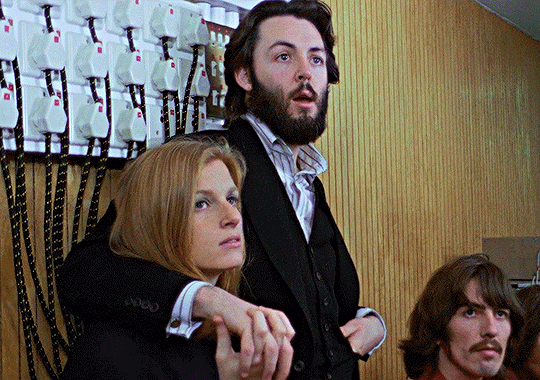

Jan. 1969 From the documentary Get Back. An arm around the shoulder and some hand holding at the same time (multitasking 😊)

March 4, 1969. At the London premiere of the film Isadora.
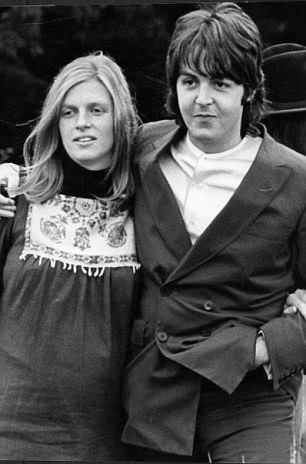
Aug. 22, 1969, six days before daughter Mary’s birth.

1970 or 1971
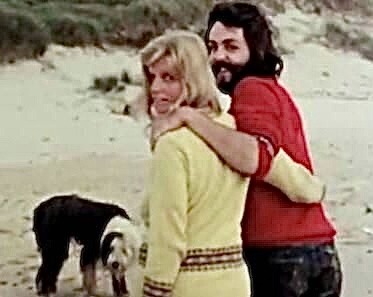
June 1971 Scotland. Still from the video for the song “Heart of The Country”


Nov. 8, 1971 Launch party for the band Wings and their debut album Wild Life at Empire Ballroom in West London.

July 16, 1972 A walk in Paris, France. Photo by Alain Dejean.

1973 Backstage during The James Paul McCartney TV special

1973.
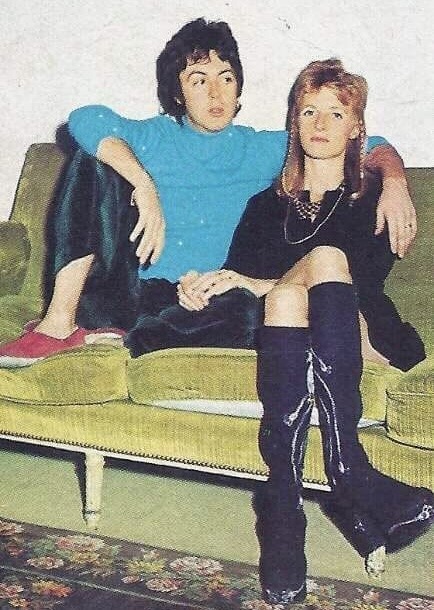
1973 An arm around Linda plus groovy footwear all in the same photo. 😎 🆒

April 1974 at Beverly Hills Hotel, where Paul and Linda stayed with their children while in L.A. to attend the Academy Awards.
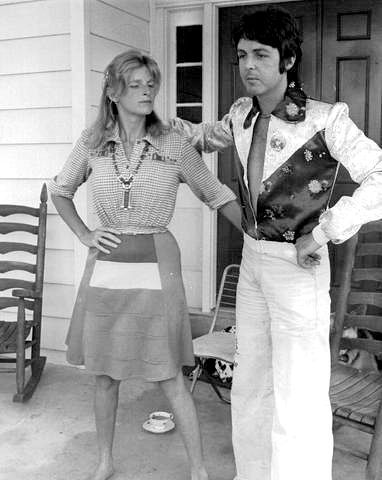
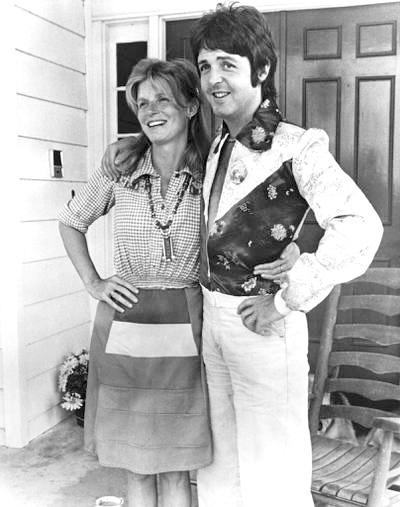
July 18, 1974 at Curly Putman’s farm in Lebanon, Tennessee (near Nashville)

Also appears to be Nashville, June or July of 1974. Paul had that haircut while he was in Nashville, and Linda had worn that same halter top in other Nashville photos.

1975 Photo shoot for People magazine cover story April 21, 1975 issue. The article title was “The McCartneys Paul & Linda,” followed by a quote from Paul: “My family is my life, then my music.” Photo by Harry Benson.
Gotta love those special pics of Paul’s hand clasping Linda’s (or vice versa), with the wedding ring(s) clearly in view.
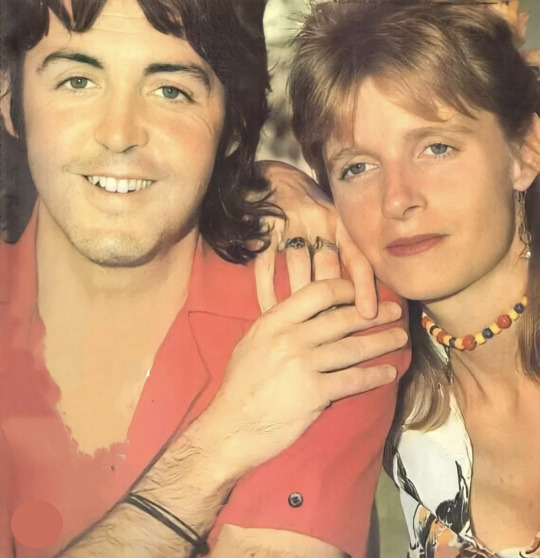
Nov. 1, 1975 Perth, Australia press conference. Another one of those lovely pics where Paul touches Linda’s hand, which happens to be touching him. 💞 💖
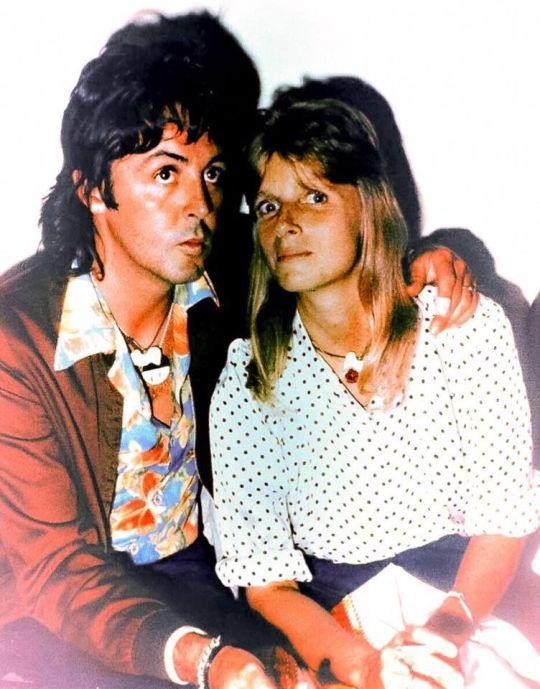
1976 during the Wings Over America Tour (May 3, 1976 to Oct. 21, 1976). This was the U.S. part of the Wings Over The World Tour (Sept. 9, 1975 to Oct. 21, 1976).
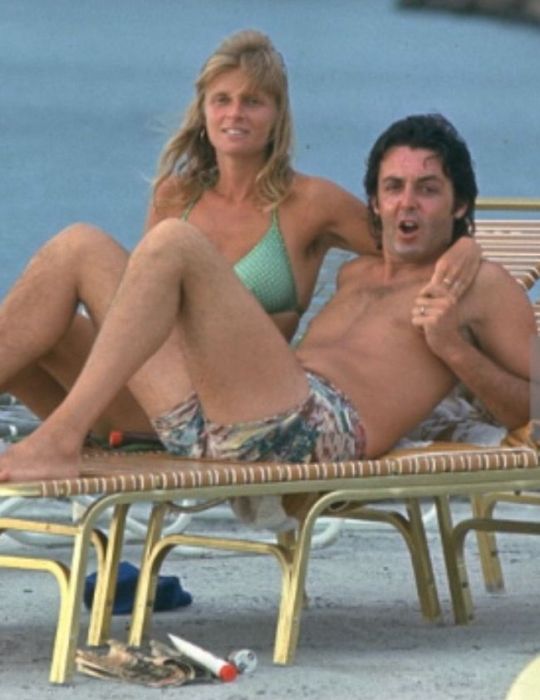
1976 Family vacation in Saint Tropez. Either Paul just woke up yawning after a nap, or he’s surprised to see a photographer nearby. Linda is looking sun-kissed with her arm draped over Paul’s shoulder. Photo by James Andanson/Sygma.
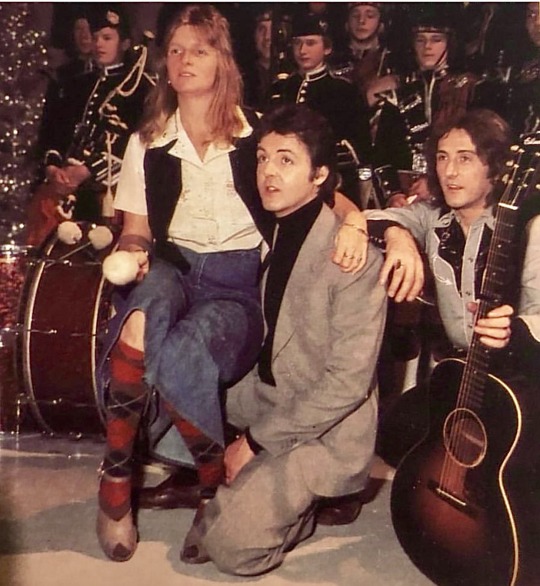
1977 With bagpipe band for appearance on Mike Yarwood Christmas Show to perform the Wings single “Mull of Kintyre.” A shortage of chairs, so Paul gives Linda his knee to sit on. What a gentleman. 🌹💐
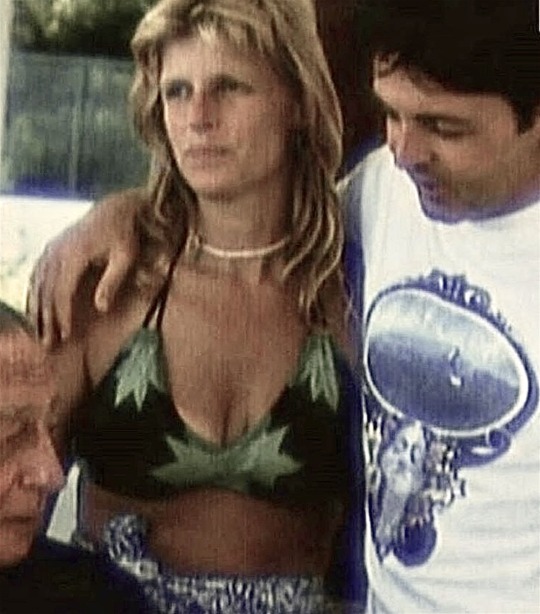
Late 1970s. Hmm, are his eyes on their guest, or on something else? 😉 😎

May 14, 1980 Cannes, France for Cannes Film Festival, where Linda and director Oscar Grillo won the Palme D’Or for best short film, Seaside Woman, a 5-minute animation based on the first song Linda wrote in 1973.
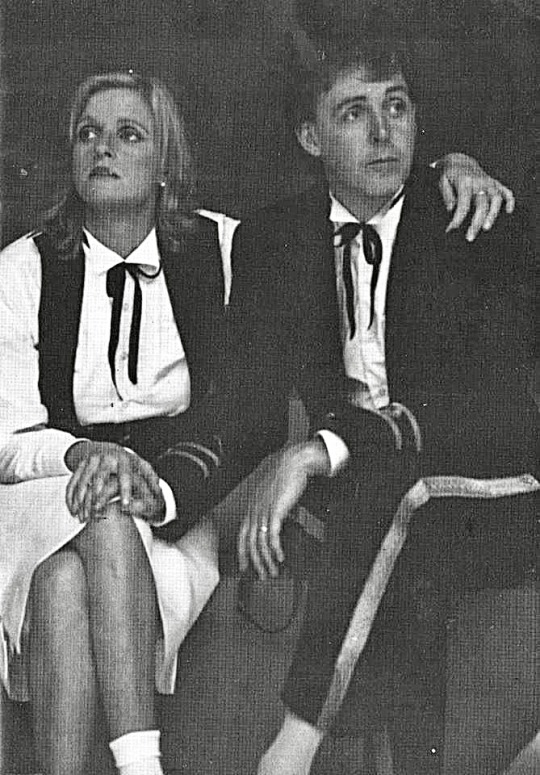
June 23, 1982 During filming of music video for the song “Take It Away” on stage 4 at Elstree Studios in Hertfordshire, U.K.
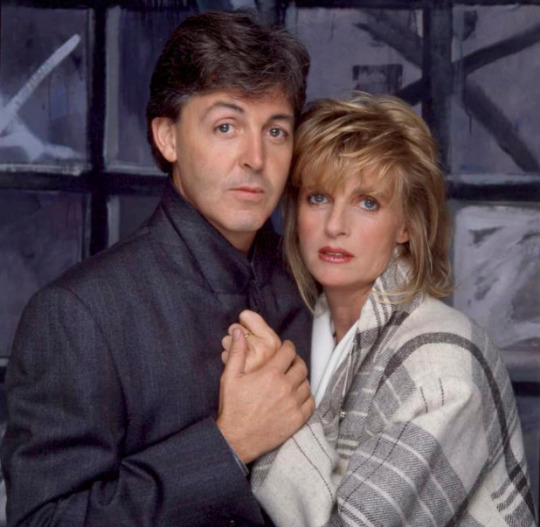
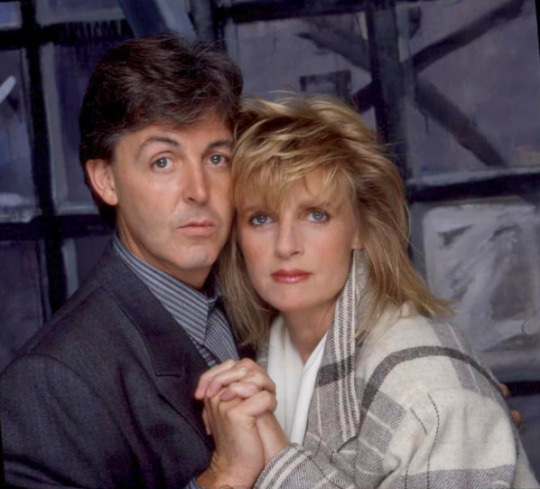
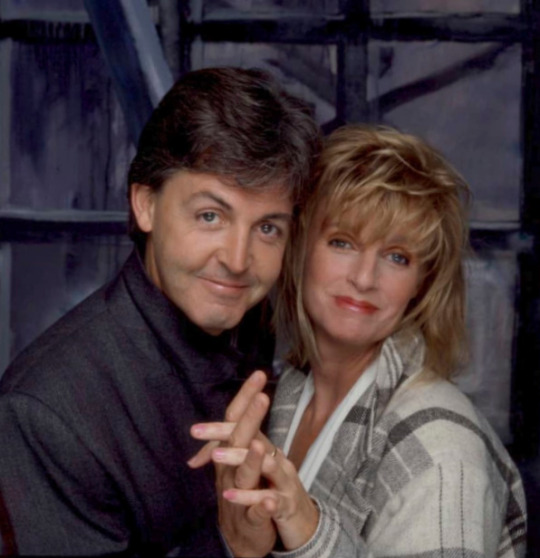

1984 🎶 I wanna hold your hand … close to my heart (aww). 😍 Photos by Terry O’Neill.
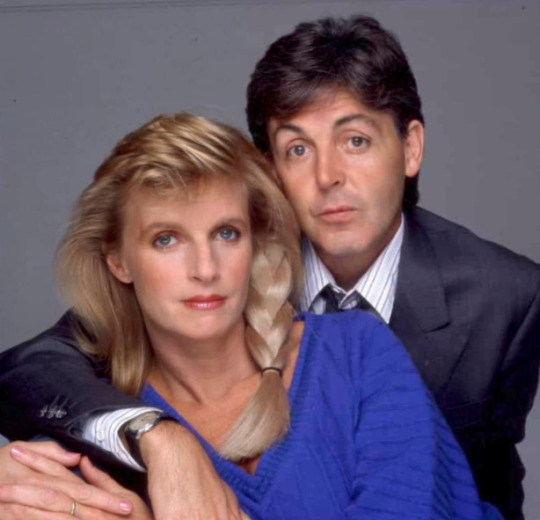
c. 1985 Photo by Terry O’Neill

1990 Photo by Bill Bernstein.
#paul mccartney#linda mccartney#paul and linda mccartney#paul and linda#paul and linda romantic#paul and linda forever#linda and paul#linda eastman mccartney#linda louise mccartney#linda mccartney and wings#lovely linda
6 notes
·
View notes
Text
Jane Birkin, Singer, Actress and Fashion Inspiration, Dies at 76
She was a lithe beauty of 1960s European film, a famous musical collaborator and lover of Serge Gainsbourg, and the namesake of elegant Hermès handbags.

By Constant Méheut and Alex Traub
Constant Méheut reported from Paris. Published July 16, 2023 Updated July 17, 2023, 11:53 a.m. ET
Jane Birkin, who helped define chic female sexuality of the 1970s as an actress in arty and erotic European movies and in her relationship — equal parts romantic and artistic — with the singer Serge Gainsbourg, died on Sunday in Paris. Ms. Birkin, who later became known for inspiring one of the best known lines of luxury handbags, was 76.
Her death was confirmed by President Emmanuel Macron of France, who called her “a French icon” in a message on Twitter. The French news media reported that Ms. Birkin had been found dead at her home but that the cause was not immediately known.
The child of a famously beautiful actress and a socially connected British naval officer, Ms. Birkin led a life guided by many happy accidents.
While she was on a flight in 1984, a plastic bag in which she was keeping her possessions broke, leading her to complain aloud that Hermès did not make a bag that could fit all her things. The man sitting next to her happened to be Jean-Louis Dumas, the chairman and head designer of Hermès. The company released the Birkin bag line the same year — in just the large size she had requested.
Standard Birkin bags now sell for $10,000, and the difficulties of obtaining one — given a complex manufacturing process and a deliberately rationed supply to boutiques — have given the bag the cachet of exclusivity.
Her relationship with Mr. Gainsbourg began just as fortuitously, in 1968. She was in her early 20s, her first marriage having fallen apart, when, without particular renown as an actress and without speaking a word of French, she managed to be cast in a French movie, “Slogan,” starring Mr. Gainsbourg.
The two fell in love, but Ms. Birkin did not see a way to remain long in France. Then, dining out one night, she had a chance encounter with the French director Jacques Deray, got hired to act in a movie of his, stayed in the country and solidified her relationship with Mr. Gainsbourg.
She lived in France for the rest of her life, and her engagement with Mr. Gainsbourg and his music proved equally enduring.
The most notable product of their collaboration and romance was their 1969 hit recording of Mr. Gainsbourg’s song “Je t’aime… moi non plus” (“I Love You… Me Neither”).
In the song, a duet, Mr. Gainsbourg speaks of sex in a low, conversational voice as Ms. Birkin confesses her love in suggestive murmurs and moans and the high-pitched singing of an ingénue.
The song was condemned by the Vatican and banned in several countries and by the B.B.C. television network. But it sold millions of copies.
Nearly 50 years later, in 2018, Ms. Birkin was still singing music by Mr. Gainsbourg, by then on a world tour of orchestral versions of his songs.
“If I am singing in Argentina in two weeks’ time,” she told The Guardian, “it is because of ‘Je t’aime.’”
Jane Mallory Birkin was born in London on Dec. 14, 1946, to Judy Campbell, an actress who gained renown for performing for British troops with Noël Coward during World War II, and Cmdr. David Birkin of the Royal Navy.
In 2021, her father’s exploits during World War II were recounted in “A Dangerous Enterprise,” a book by Tim Spicer, a former British military officer. Commander Birkin’s duties included navigating boats on moonless nights across the English Channel to bring to safety Allied spies, stranded airmen and escaped prisoners of war who had found themselves in France.
Ms. Birkin, at 18, married the British composer John Barry, known for arranging the trademark theme to James Bond movies, and they had a daughter, Kate. At 20, Ms. Birkin appeared in Michelangelo Antonioni’s hit 1966 movie, “Blow Up,” an erotic tale of a London fashion photographer. She played a fashion model — the credits listed her as only The Blonde — and gained some attention for a risqué nude scene.

“Had it all worked out with John Barry, I would never have been curious to know what was going on anywhere else,” Ms. Birkin told The Guardian in 2017. “I would have just gone on being his wife. I would have been delighted. But because he went off with someone else, and I was left with Kate, I had to find a job quite fast.”
That led to her audition for “Slogan.”
The movie that kept her in France was “La Piscine” (“The Swimming Pool”), starring Alain Delon and Romy Schneider. (It found unexpected renewed popularity in the United States in 2021.) A sun-soaked film of sex and jealousy with many shots of scantily clad actors, the movie proved to be an effective showcase for Ms. Birkin’s long-limbed beauty.
Her romance with Mr. Gainsbourg captivated the French public. She was the young doe-eyed expat, he the aging but still virile artistic genius. The relationship lasted for more than a decade, ending when she left him in the early 1980s for the French film director Jacques Doillon. Mr. Gainsbourg died in 1991 at 62.
Though Ms. Birkin would later speak self-deprecatingly about her role as Mr. Gainsbourg’s muse, she embraced becoming “the keeper of the Gainsbourg flame,” as The New York Times labeled her in 2018.
She described to The Times connections between the music he wrote for her and work by classical composers like Chopin and Brahms.
“I would have thought that he was probably France’s most modern writer,” she said. “He invented a new language, he cut words in two like Cole Porter.”

Ms. Birkin released “Oh! Pardon tu dormais…,” her first album of her own songs written in English, in 2021. “The results are an emotional tour de force from an artist who has never gotten her musical due outside of France,” the music writer Ben Cardew wrote in a review for Pitchfork.
Ms. Birkin also continued to act, including in films by Agnès Varda and plays by Patrice Chéreau. She was also popular in France as an activist for women’s and L.G.B.T.Q. rights as well as for her British accent when speaking French, which the French found endearing.
“The most Parisian of the English has left us,” the mayor of Paris, Anne Hidalgo, wrote in a message on Twitter on Sunday. “We will never forget her songs, her laughs and her incomparable accent.”

Ms. Birkin had a mild stroke in 2021 and had recently canceled a series of concerts because of health issues.
She is survived by two daughters, one with Mr. Gainsbourg and the other with Mr. Doillon: the singer-actresses Charlotte Gainsbourg and Lou Doillon, each of whom has, like their mother, inspired designers and followers of fashion. Her other daughter, Kate Barry, a photographer, died at 46 in 2013 in a fall from a window of her fourth-floor Paris apartment.
Ms. Birkin discovered that her romantic separation from Mr. Gainsbourg did not dim their collaboration. He kept writing new songs intended for her until he died.
After their breakup, “you could talk back to him for once,” she told The Guardian. “You were not just his creation any more.”
Guy Trebay contributed reporting from New York.
0 notes